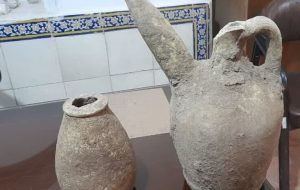Historical earthenware unearthed in downtown Isfahan
TEHRAN – Some historical earthenware has recently been unearthed in a serendipitous find when workers excavated the floor of a bank nestled within the bustling grand bazaar of Isfahan. “Workers discovered 13 pottery objects while they were collecting the floor space of a branch of the Bank Melli Iran situated on the main thoroughfare of


TEHRAN – Some historical earthenware has recently been unearthed in a serendipitous find when workers excavated the floor of a bank nestled within the bustling grand bazaar of Isfahan.
“Workers discovered 13 pottery objects while they were collecting the floor space of a branch of the Bank Melli Iran situated on the main thoroughfare of the historical bazaar of Isfahan, the spokesperson for the Cultural Heritage, Tourism, and Handicrafts Department of Isfahan province, explained on Thursday.
“The location of the bank which is situated near Ashraf gate (a Safavid era place), raises the possibility of the projects to date back to the Safavid era,” Shahram Amiri said.
“The bank officials had requested the renovation and reconstruction of the bank building some time ago, and it was during the process of collecting the bank’s flooring and excavating for groundwork yesterday that these pottery pieces were discovered.”
Amiri emphasized that the historical significance of these pottery pieces has been confirmed, and there is a possibility of discovering more pottery as the operation continues.
“Experts from the Historical Directorate confirmed the historical nature of these pottery pieces, but the exact period to which they belong will be determined by laboratory analysis conducted by the Heritage Laboratory in the coming days,” the official added.
In another accidental discovery made weeks ago, construction works unearthed an array of ruins and relics in Isfahan, which according to archaeologist Ali Shojaei Isfahani may date from the early Islamic era to the Qajar epoch. The discovery was made on the Kamar-Zarrin passageway during a routine urban project.
The ancient city of Isfahan is celebrated not only for its magnificent historical monuments but also for the life-giving presence of the Zayandeh-Rood River, which has long graced the city with its original beauty and fertility.
Isfahan has earned the enduring moniker of Nesf-e-Jahan, translating to “half the world,” signifying that to behold it is to behold half the world. During its zenith, it stood as one of the largest cities in the region, boasting a population of nearly one million.
The serene azure tiles adorning Isfahan’s Islamic edifices, coupled with the city’s grandiose bridges, provide a striking juxtaposition against the arid expanse of the surrounding Iranian countryside. At the heart of the city lies the vast Imam Square, renowned as Naghsh-e Jahan Square, meaning “Image of the World,” a monumental testament to urban planning. Constructed in the early 17th century, this UNESCO-recognized square spans an impressive 500 meters by 160 meters and hosts some of the most captivating sights in Isfahan.
AM
